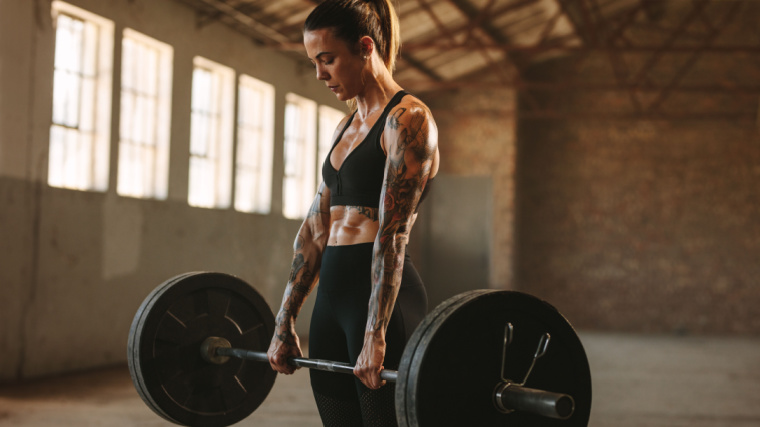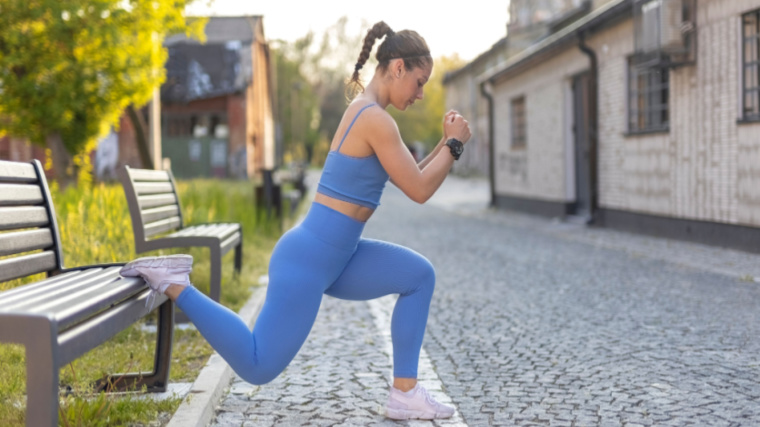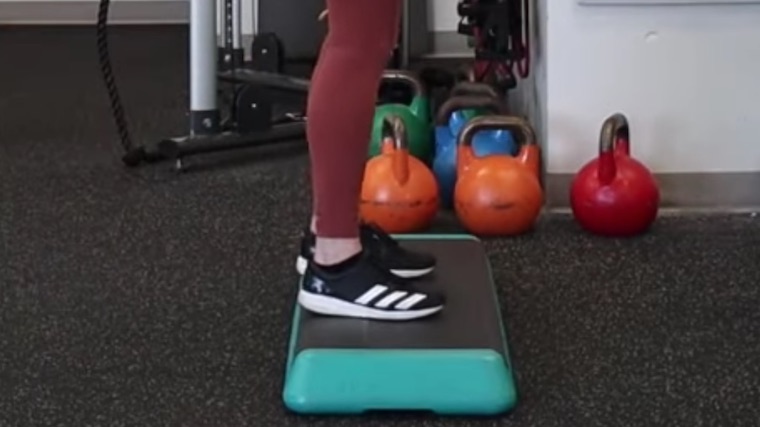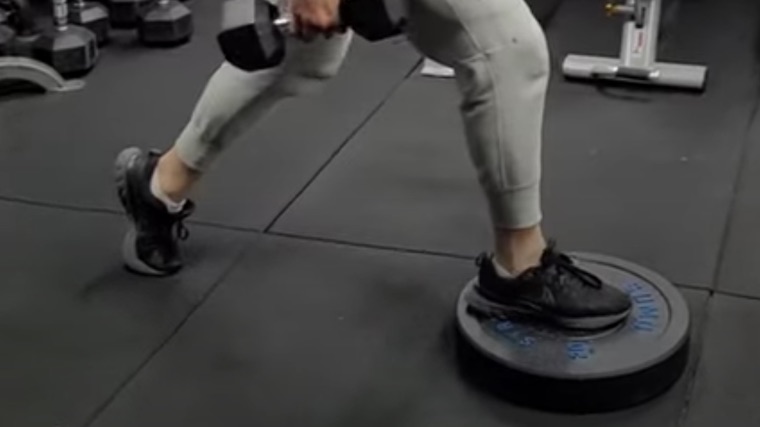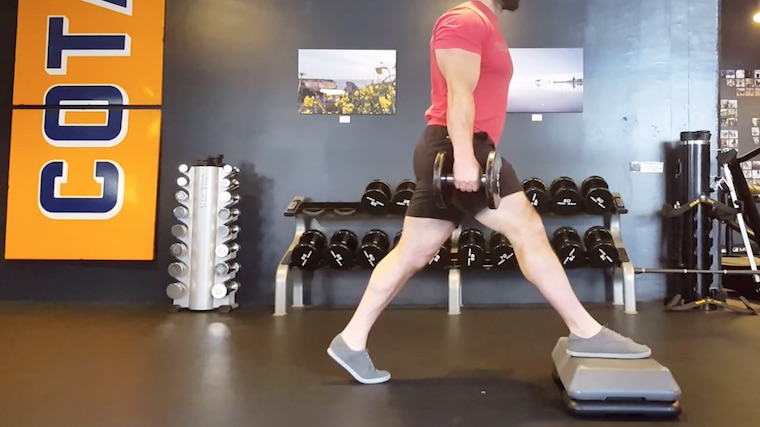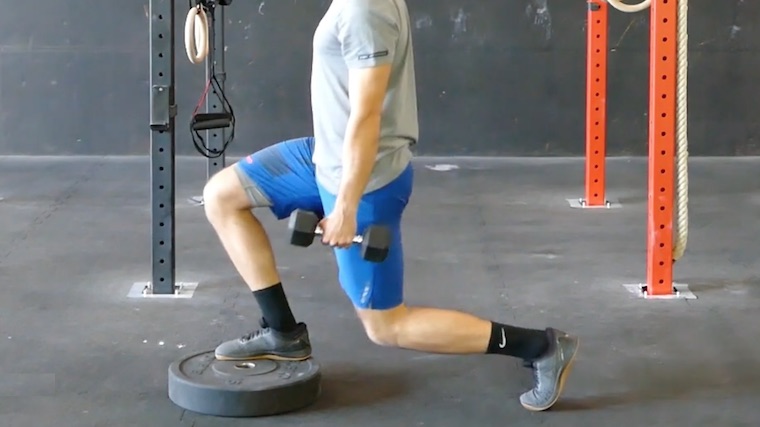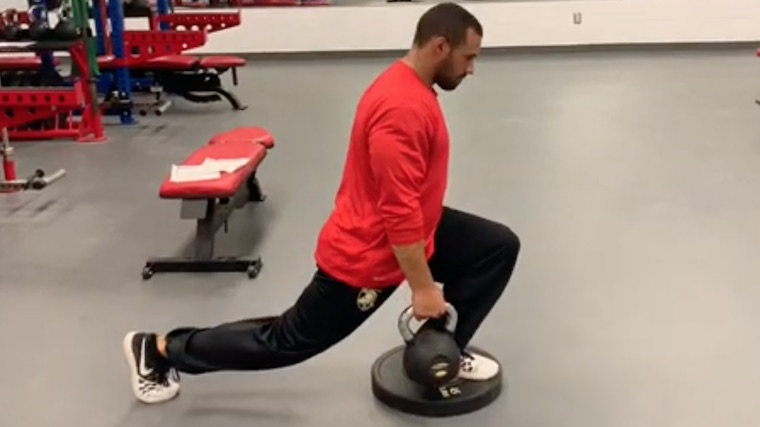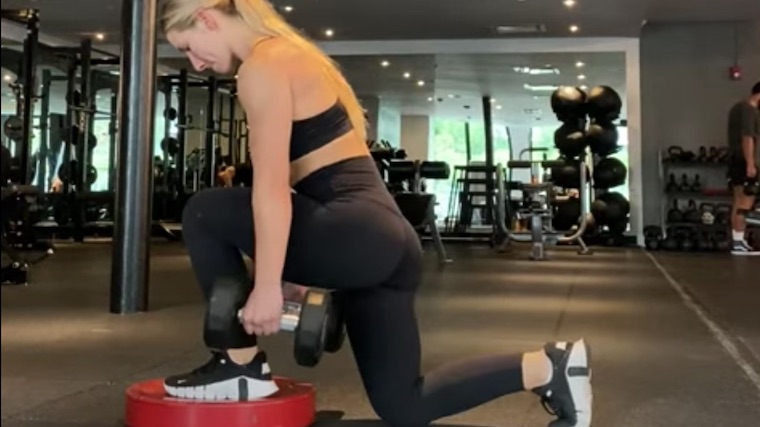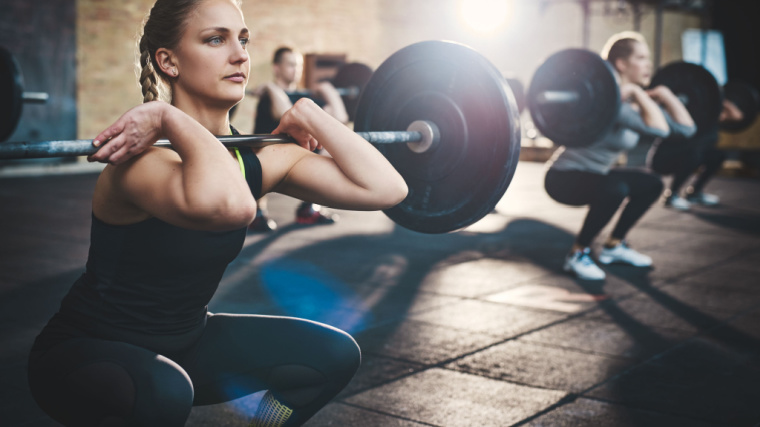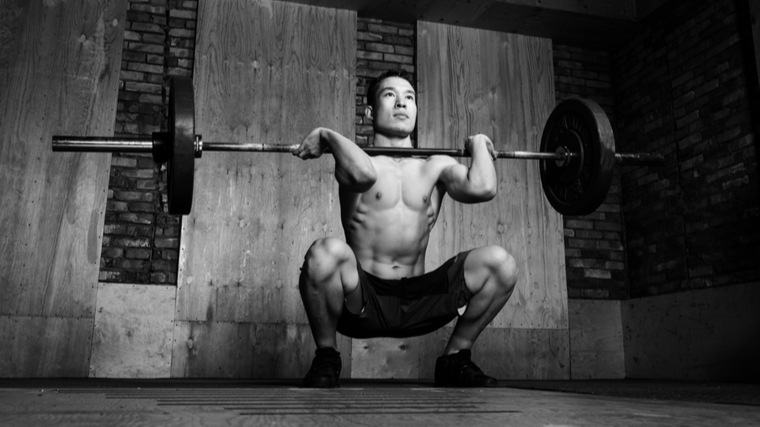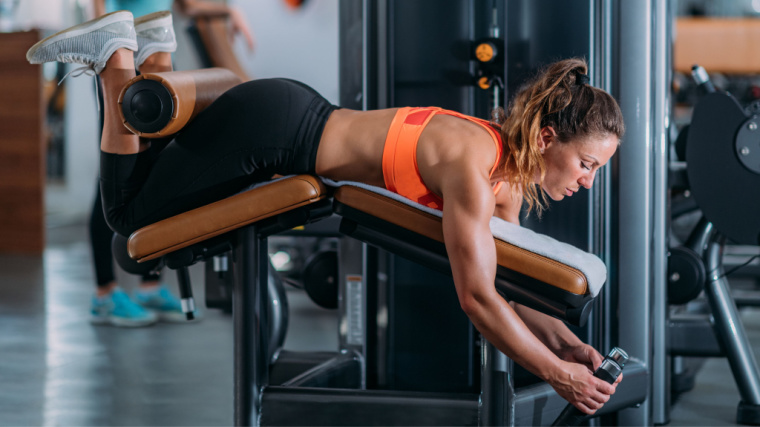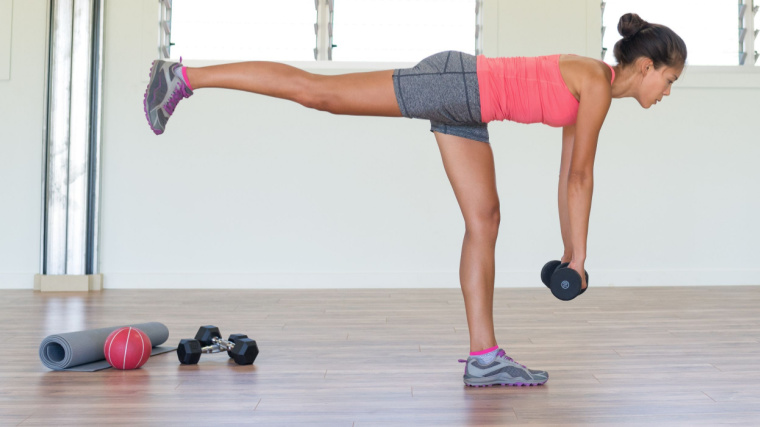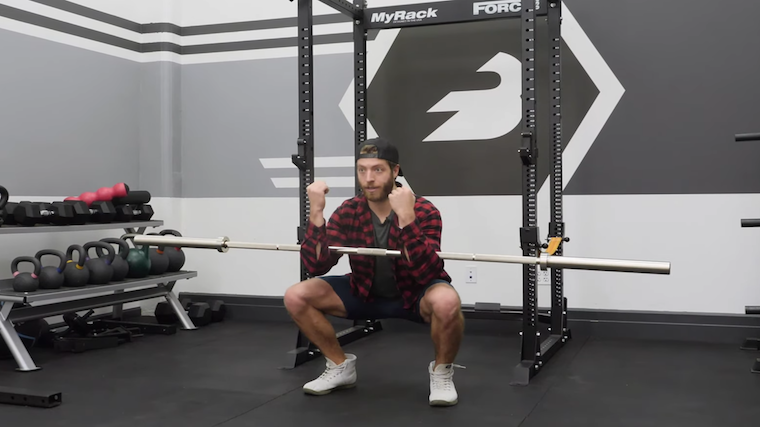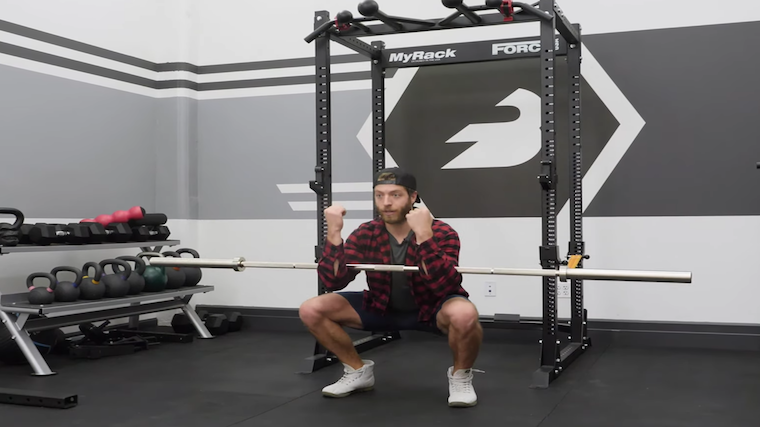Squats are probably the first exercise a person ever performs — simply standing up from the ground. This is likely why squats are often dubbed as the king of exercises. Indeed, they are one of the best, if not the best exercises to develop lower body size, strength, and power while making you a universally stronger athlete with a core of steel.
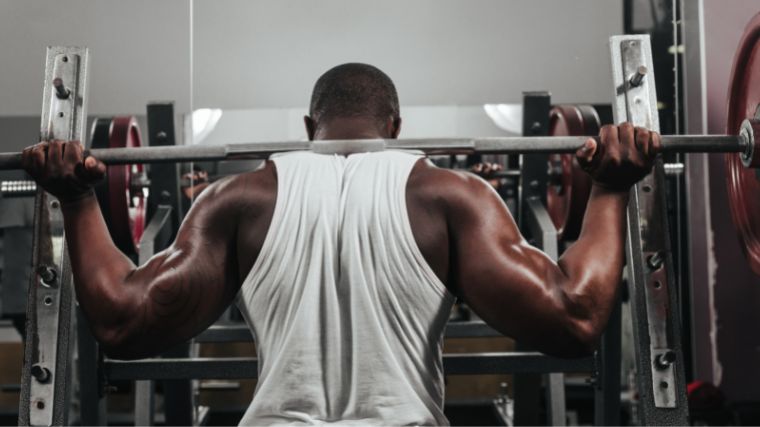
When lifters talk about squats, they’re generally referring to the barbell back squat, even though there are many different ways to perform “a squat.” But there are even two primary types of back squats — the low-bar squat and the high-bar squat. In the high-bar squat, the barbell is resting on your upper traps, while the low-bar position nestles the bar across your posterior deltoids or even lower in some extreme cases.
Even though the two exercises might look similar from a distance, they have their own benefits and one or the other might better suit your specific goals. To figure out which squat setup is best for you, let’s compare them.
Low-Bar Squat and High-Bar Squat
Exercise Differences
At first glance, there are only a few inches of difference in bar placement. Surely that can’t make a dramatic difference, can it? It can. Here’s how each squat best serves a different purpose.
Strength Potential
Setting the barbell in a lower position decreases the moment arm between the bar and your hips. As such, you can use heavier loads with the low-bar squat. The lever is shorter, which means the same amount of force generated by your hips and back muscles, you can move more weight.
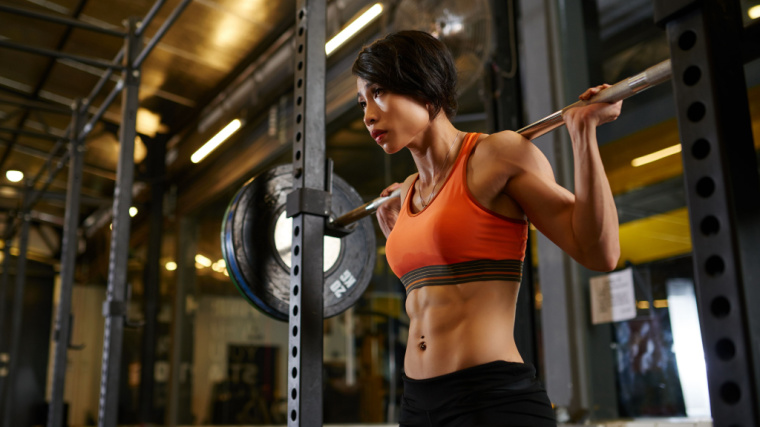
Your core is also more compact and resilient, and your upper back is stronger in a low-bar position. You face less risk of bending forward or having your upper back collapse with the low-bar squat.
This is why this variation is favored by powerlifters and most strength athletes. Some of them even put the barbell as low on their back as it can be without sliding down — to decrease the moment arm as much as possible, improve their leverage, and lift as much weight as possible. If you’re concerned with lifting as much weight as possible, then you should probably make the low-bar squat your primary choice. (1)
Muscle Recruitment
One consequence of having the barbell lower is that you have to adopt a more forward-leaning torso position. This increases your hip angle and, the greater it is, the more you’ll recruit your hip muscles: glutes, lower back, and hamstrings.
On the other hand, with the high-bar squat, you can maintain a more upright posture, but it increases knee flexion. You’ll put more stress on your quadriceps and it will be easier to feel them working. You also target the abs more because they’re more strongly recruited in an upright position.
This makes the low-bar squat more of a “posterior chain”-dominant movement (emphasizing your glutes, lower back, and hamstrings) while the high-bar squat also recruits your “anterior chain” (emphasizing your quadriceps and abdominals).
This is why the high-bar squat is the more common choice for bodybuilders and physique-focused lifters.The exercise suits those interested in building more muscular legs, particularly the relatively larger quadriceps.
Go with the high-bar squat if you want to emphasize your quads, but use low-bar squats if you’re more concerned with targeting your glutes and hamstrings.
Technique and Mobility
It can be difficult to find your ”groove” and adapt to low-bar squatting. You have to find your own ideal torso angle, decide an optimal barbell position, determine how much to sit back, etc. And this is emphasized because mobility requirements in your shoulders and hips will dictate the limits of your form.
Indeed, the barbell position in a low-bar squat requires a good deal of shoulder mobility to hold the bar in position, as well as external rotation and wrist stability. Low-bar squats are notorious for putting a relatively high degree of stress on your wrists and shoulders. This is why some powerlifters wear wrist wraps when squatting, or avoid the low-bar squat to save shoulder strain for their bench press.
If you have no mobility issues or old injuries nagging you, you’re good to go. But if you’re a battered gym veteran, or if your shoulders and elbows are tender, stick to the high-bar squat — at least until the pain and issues are gone and you have developed adequate mobility to squat pain-free.
Exercise Similarities
With both exercises being squats, they do share many similarities and overlapping benefits.
Bilateral Development
Both types of squats are multi-joint leg exercises that involve hip, knee, and ankle joints to work many muscle groups including the quadriceps, hamstrings, glutes, and even your back and core. (2) Squats will mainly grow your legs, but they can actually contribute to making your whole body bigger and stronger. (3)
Because these squats work both lower body limbs at the same time, you’re more stable, and can generate more strength, lift more weight, and potentially stimulate more hypertrophy. They also help save time since you don’t have to switch legs with every set you perform.
Posterior Loading
Compared to other squats variations, both the low-bar and the high-bar squat are back squats, meaning that the loading is focused on your posterior chain because the bar is resting on your upper back muscles. This isn’t the case, for instance, with the Zercher squat or front squat which load the front half of your body and emphasize your anterior chain.
As such, both the low-bar squat and high-bar squat have the potential to load relatively heavy weight and they are effective for building strength. Compared to front-loaded squat movements, your torso is less upright and you undergo more hip flexion and less knee flexion.
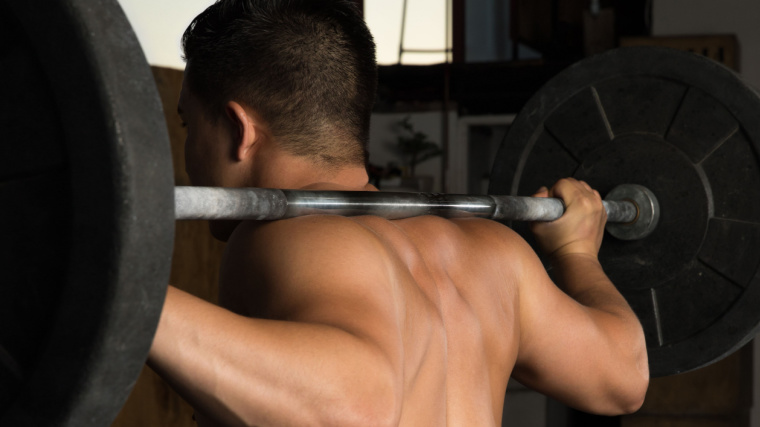
The back-focused bar position, whether it’s low-bar or high-bar, implies more recruitment in the posterior chain — hamstring, glutes, and lower back — and less recruitment in the anterior chain — quadriceps and abs. (4) If you’re interested in developing your posterior chain and lifting plenty of weight, then one of these back squat variations are your go-to.
How to Do the Low-Bar Squat
With the low-bar squat, the barbell is not placed on the traps. Get under a barbell and position it even lower, on your posterior deltoid (the rear of your shoulders) above the top of your armpits. Squeeze your shoulder blades as much as possible to create a “shelf” needed to hold the barbell in place. Bend forward slightly at the waist to prevent the bar from moving around or possibly falling.
Once the barbell is secure, step back and adopt a shoulder-width (or slightly wider) stance. Bend at your hips and knees until your thighs break parallel with the floor. Aim to keep the barbell over your midfoot at all times. This keeps you in a powerful position of leverage.. Push back up until your legs are straight.
Form tip: To help create the cushion of arm, shoulder, and upper back muscles necessary to hold the barbell in position, bring your hands slightly closer. This will help you squeeze your shoulder blades even more. It might prove uncomfortable at first, so make sure to properly warm-up your shoulders and back before low-bar squatting.
Benefits of the Low-Bar Squat
- The low-bar squat puts you in a position to lift the most weight of any squat variation. This is the one you want to prioritize if you want to compete in strength sports like powerlifting or strongman/strongwoman contests, or if you’re simply interested in lifting really heavy weights for fun.
- Low-bar squats deliver more posterior chain recruitment. Your glutes, hamstrings, and lower back will be activated more than with other squat variations.
Low-Bar Squat Variations
If you want to give your shoulders a break, or want to attack the squat from another angle, here are some variations you might want to try.
Safety Bar Squat
If you have access to a safety bar, it can be an excellent piece of gym equipment. Its main purpose is to make the exercise less stressful on your shoulders, elbows, and neck. In summary, it’s a very accessible squat for people who have joint mobility issues. You can mimic the low-bar squat torso angle and general technique, while sitting back farther and bending forward with less trouble.
The safety bar squat also has the benefits of overloading your traps, upper back, and abs. (5) If the low-bar squat irritates your shoulders or if you want to improve your upper back strength, give this variation a go.
Box Squat
Technically, you could do box squats with a high-bar position, but the overall mechanics and purpose of box squats are better suited with the low-bar position. For this variation, you use a box or a bench, sit back, and squat down. Pause for a second on the bench or box, then contract your glutes and hamstrings to explode upwards. Don’t allow yourself to crash down uncontrolled onto the box.
This movement is a favorite among powerlifters because it’s a great way to teach proper squatting mechanics and consistent depth. The box squat also recruits your posterior chain more efficiently and teaches you to improve explosive power out of the bottom position.
How to Do the High-Bar Squat
Position yourself in front of a barbell in a rack, then duck under and position the bar to sit in the “shelf” of your upper back and traps. Do not rest the bar on your neck or cervical spine. When you have a somewhat comfortable position, grip the bar tightly and unrack it.
Take one step back, then another small step to adjust your position. Your feet should be around shoulder-width, but your exact stance will vary slightly depending on your individual morphology. If you have longer legs, you may be more comfortable with a slightly wider stance.
Take a deep breath and brace your core. Bend your knees and hips simultaneously until the crease of your hips is lower than your knees. Stand up with the weight, exhaling as you pass the midpoint of the repetition.
Form tip: Make sure that your big toes, little toes, and heels are always in contact with the ground. It will help you engage your glutes and should prevent bending forward during the ascent.
Benefits of the High Bar Squat
- This is one of the best exercises to develop muscle throughout your lower body, especially your quadriceps. The powerful stimulus of this total-body exercise is an incredible trigger for overall size and strength.
- High-bar squats are a relatively simple and beginner-friendly barbell squatting variation.
- This movement will put relatively low stress on your joints, particularly sparing your hips from excessive strain.
High-Bar Squat Variations
If you want to take things to the next level and go beyond the traditional high-bar squat, try these variations. Each has its own benefits and could be a better suit for your training goal once you master the initial exercise.
Smith Machine Squat
The Smith machine has the advantage of being more stable since the bar is on a guided rail. As such, this variation will require less stability and coordination, and you can push yourself harder with reduced risk of injury (from dropping the bar of fatiguing your core and upper body). This is a useful variation if you want to turn up the intensity and approach or reach muscular failure.
It also allows you to focus on the mind-muscle connection and really feel your legs working. This is an ideal exercise if you prioritize hypertrophy or overall safety above strength and heavy weights.
Front Squat
With the high-bar squat, you’re standing quite upright, but the front squat takes things to the next level by demanding super-strict form — if you bend forward, the bar will roll away. This is a useful exercise for teaching good general squat mechanics. The front squat also prevents the lifter from bending too far forward, which would turn the squat into a lower-back focused good morning exercise.
The front-loaded position of the front squat will also emphasize your quadriceps and core even more than other squat variations. It’s a prime choice to boost your Olympic lifts and has direct carryover to the clean & jerk. However, a proper front squat requires a degree of thoracic (upper back), shoulder, and wrist mobility, so it may not be an immediate option for all lifters without doing some mobility work. Choose the front squat if you want to grow your quadriceps as much as possible, improve your core strength, or support your Olympic lifts.
How to Program the Best Squat For You
Both of these lifts are bilateral multi-joint exercises, recruiting a ton of muscles. As such, they can be an effective fit in many training programs for a variety of purposes.
Building Strength
To get as strong as possible, your best bet is to use three to five sets of one to five repetitions with a heavy weight. Both variations are suited for this kind of programming. Which one you employ will depend on your goals. If you’re a powerlifter or a strongman/strongwoman, stick to the low-bar squat, as it is the one with which you lift the most overall weight.
If you’re an Olympic weightlifter or a CrossFitter, the high-bar squat will be your variation of choice, as it has more carryover to the Olympic lifts and the movements you’ll find in competition. If you’re a general gym-goer, pick the variation that feels most natural.
Growing Muscle
For maximal muscle growth, use a classic repetition scheme of three to four sets of eight to 12 repetitions. The lower rep range will deliver a moderately heavy stress on the body, while the longer duration sets create a burning sensation for muscle growth.
If your goal is to build muscle, either squat setup could be useful, but most experienced bodybuilders and physique-focused lifters stick with the high-bar squat. Why? They’re not concerned with putting the biggest weights on the bar, but with getting the biggest muscles.
The high-bar squat will target your quadriceps, which are among the biggest muscles on the human body. High-bar squats also put relatively less stress on your shoulders and elbows, which sometimes take a beating from various presses, extensions, and assorted upper body training.
Explosive Power
If you’re an athlete trying to run faster or jump higher, it’s a good idea to add some explosive, power-based squats to your training regimen. Five to 10 sets of two to five reps, using a moderately heavy weight that you can still accelerate, will be your best bet. Stick to the high-bar squat. The general technique and muscle recruitment will have the most carryover to improving jumping and running.
Don’t End Up With Diddly Squat
Squats are dubbed the king of exercises for a reason. Don’t miss out on back squats. Use the bar position best suited to your body and goals, whether you want to build an impressive set of wheels, lift a pile of weight, become a better athlete, or boost your overall fitness.
References
- Glassbrook, Daniel J.1; Brown, Scott R.1; Helms, Eric R.1; Duncan, Scott1; Storey, Adam G.1,2. The High-Bar and Low-Bar Back-Squats: A Biomechanical Analysis. Journal of Strength and Conditioning Research 33():p S1-S18, July 2019. | DOI: 10.1519/JSC.0000000000001836
- Ribeiro, Alex S. PhD1,2; Santos, Erick D. MSc1,2; Nunes, João Pedro MSc2; Nascimento, Matheus A. PhD2,3; Graça, Ágatha MSc3; Bezerra, Ewertton S. PhD4; Mayhew, Jerry L. PhD5. A Brief Review on the Effects of the Squat Exercise on Lower-Limb Muscle Hypertrophy. Strength and Conditioning Journal 45(1):p 58-66, February 2023. | DOI: 10.1519/SSC.0000000000000709
- Myer GD, Kushner AM, Brent JL, Schoenfeld BJ, Hugentobler J, Lloyd RS, Vermeil A, Chu DA, Harbin J, McGill SM. The back squat: A proposed assessment of functional deficits and technical factors that limit performance. Strength Cond J. 2014 Dec 1;36(6):4-27. doi: 10.1519/SSC.0000000000000103. PMID: 25506270; PMCID: PMC4262933.
- Yavuz HU, Erdağ D, Amca AM, Aritan S. Kinematic and EMG activities during front and back squat variations in maximum loads. J Sports Sci. 2015;33(10):1058-66. doi: 10.1080/02640414.2014.984240. Epub 2015 Jan 29. PMID: 25630691.
- Hecker KA, Carlson LA, Lawrence MA. Effects of the Safety Squat Bar on Trunk and Lower-Body Mechanics During a Back Squat. J Strength Cond Res. 2019 Jul;33 Suppl 1:S45-S51. doi: 10.1519/JSC.0000000000002912. PMID: 30363042.
Featured Image: Dusan Petkovic / Shutterstock
